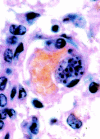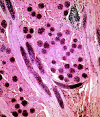Sarcocystis spp. in human infections
- PMID: 15489353
- PMCID: PMC523554
- DOI: 10.1128/CMR.17.4.894-902.2004
Sarcocystis spp. in human infections
Abstract
Sarcocystis species are intracellular protozoan parasites with an intermediate-definitive host life cycle based on a prey-predator relationship. Asexual stages develop in intermediate hosts after they ingest the oocyst stage from definitive-host feces and terminate with the formation of intramuscular cysts (sarcocysts). Sarcocysts in meat eaten by a definitive host initiate sexual stages in the intestine that terminate in oocysts excreted in the feces. Most Sarcocystis species infect specific hosts or closely related host species. For example, humans and some primates are definitive hosts for Sarcocystis hominis and S. suihominis after eating raw meat from cattle and pigs, respectively. The prevalence of intestinal sarcocystosis in humans is low and is only rarely associated with illness, except in volunteers who ingest large numbers of sarcocysts. Cases of infection of humans as intermediate hosts, with intramuscular cysts, number less than 100 and are of unknown origin. The asexual stages, including sarcocysts, can stimulate a strong inflammatory response. Livestock have suffered acute debilitating infections, resulting in abortion and death or chronic infections with failure to grow or thrive. This review provides a summary of Sarcocystis biology, including its morphology, life cycle, host specificity, prevalence, diagnosis, treatment, and prevention strategies, for human and food animal infections.
Figures







References
-
- Arness, M. K., J. D. Brown, J. P. Dubey, R. C. Neafie, and D. E. Granstrom. 1999. An outbreak of acute eosinophilic myositis due to human Sarcocystis parasitism. Am. J. Trop. Med. Hyg. 1:548-553. - PubMed
-
- Aryeetey, M. E., and G. Piekarski. 1976. Serologische Sarcocystis-studien an Menschen und Ratten. Z. Parasitenkd. 50:109-124. - PubMed
-
- Beaver, P. C., R. K. Gadgil, and P. Morera. 1979. Sarcocystis in man: a review and report of five cases. Am. J. Trop. Med. Hyg. 28:819-844. - PubMed
-
- Bunyaratvej, S., P. Bunyawongwiroj, and P. Nitiyanant. 1982. Human intestinal sarcosporidiosis: report of six cases. Am. J. Trop. Med. Hyg. 31:36-41. - PubMed
-
- Chen, X., Y. Zuo, and W. Zuo. 1999. Observation on the clinical symptoms and sporocysts excretion in human volunteers experimentally infected with Sarcocystis hominis. Zhongguo Ji Sheng Chong Xue Yu Ji Sheng Chong Bing Za Zhi 17:2527. (In Chinese.) - PubMed
Publication types
MeSH terms
LinkOut - more resources
Full Text Sources
Miscellaneous

